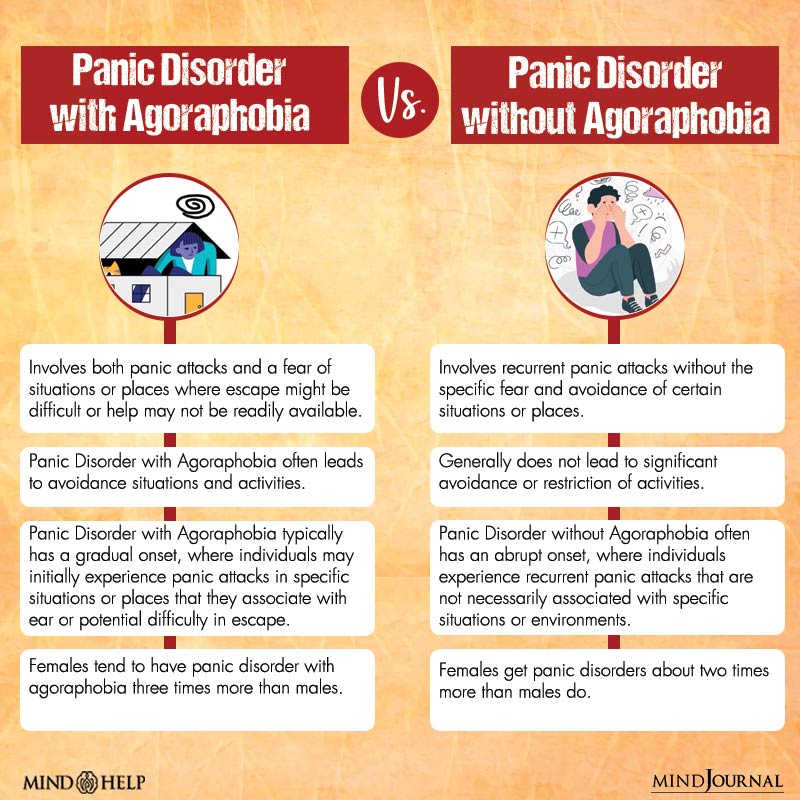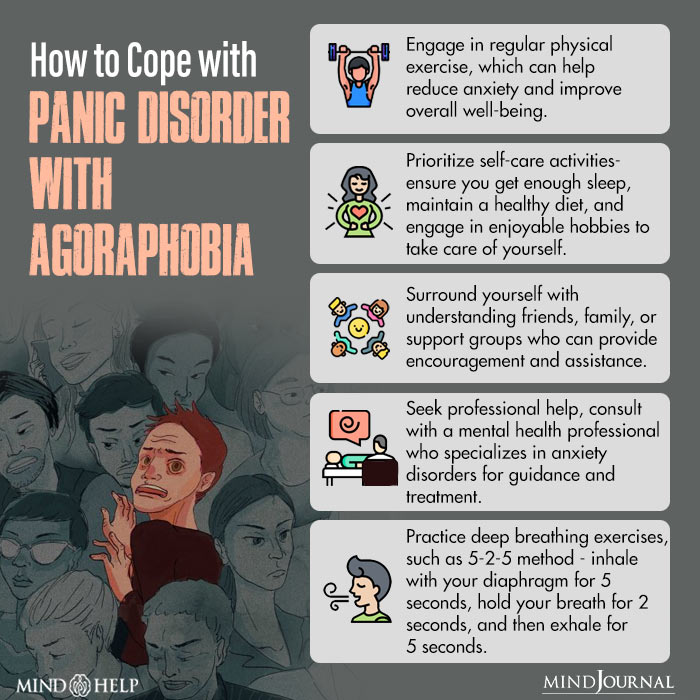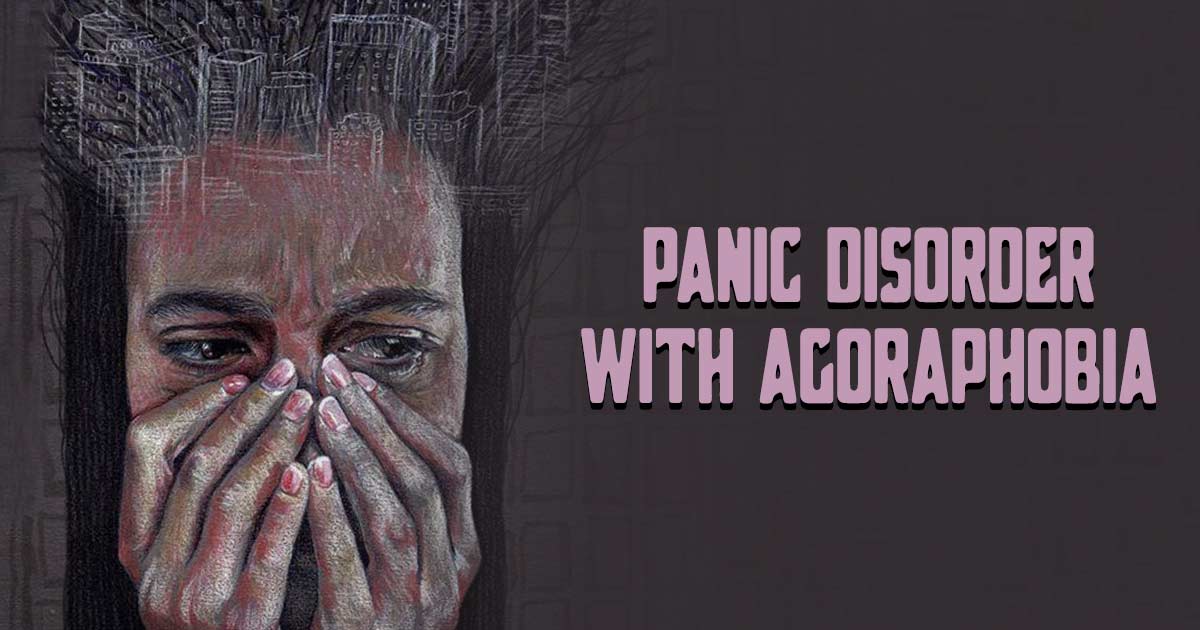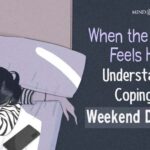Panic Disorder with Agoraphobia is a psychological condition marked by recurring panic attacks and an intense fear of being in situations where escape could be challenging. People with panic attack with agoraphobia frequently avoid or experience distress in environments that may provoke panic symptoms, resulting in substantial disruptions to their daily lives functioning and overall well-being.
What is Panic Disorder with Agoraphobia
Panic Disorder is a condition 1 Bonevski, D., & Naumovska, A. (2020). Panic Attacks and Panic Disorder. Psychopathology – an International and Interdisciplinary Perspective. https://doi.org/10.5772/intechopen.86898 characterized by sudden and intense episodes of fear or discomfort known as panic attacks. These attacks can occur unexpectedly and bring about distressing symptoms such as a racing heartbeat, difficulty breathing, and excessive sweating.
Agoraphobia, on the other hand, is an anxiety disorder 2 Balaram, K., & Marwaha, R. (2023, February 13). Agoraphobia. PubMed; StatPearls Publishing. Available from: https://www.ncbi.nlm.nih.gov/books/NBK554387/ where individuals fear and avoid specific situations or places where they believe they may become trapped or unable to seek help if they were to have a panic attack.
When individuals experience panic attacks, they may develop a fear of experiencing them again. This fear can lead to avoiding certain environments or activities that they associate with their previous panic attacks. As time goes on, this avoidance behavior can progress into agoraphobia, where individuals feel trapped or helpless in situations they fear could trigger a panic attack.
The estimated lifetime prevalence rate 3 de Jonge, P., Roest, A. M., Lim, C. C., Florescu, S. E., Bromet, E. J., Stein, D. J., Harris, M., Nakov, V., Caldas-de-Almeida, J. M., Levinson, D., Al-Hamzawi, A. O., Haro, J. M., Viana, M. C., Borges, G., O’Neill, S., de Girolamo, G., Demyttenaere, K., Gureje, O., Iwata, N., Lee, S., … Scott, K. M. (2016). Cross-national epidemiology of panic disorder and panic attacks in the world mental health surveys. Depression and anxiety, 33(12), 1155–1177. https://doi.org/10.1002/da.22572 for the symptoms of agoraphobia with panic disorder is around 1.1 percent. Agoraphobia with Panic Disorder is a combination 4 Hamm, A. O., Richter, J., Pané-Farré, C., Westphal, D., Wittchen, H. U., Vossbeck-Elsebusch, A. N., Gerlach, A. L., Gloster, A. T., Ströhle, A., Lang, T., Kircher, T., Gerdes, A. B., Alpers, G. W., Reif, A., & Deckert, J. (2016). Panic disorder with agoraphobia from a behavioral neuroscience perspective: Applying the research principles formulated by the Research Domain Criteria (RDoC) initiative. Psychophysiology, 53(3), 312–322. https://doi.org/10.1111/psyp.12553 of these two conditions, where individuals not only experience panic attacks but also have a fear of situations where they may feel embarrassed or unable to escape or find help if a panic attack were to occur.
Case Example:
Ginny, a 32-year-old woman, has been struggling with sudden feelings of terror and physical discomfort, such as a fast heartbeat, difficulty breathing, dizziness, trembling, choking, shaking, palpitations, stomach discomfort, and chest pain for the past 6 months.
These attacks come without warning and can last for a few minutes, leaving her exhausted and drained. Because of this, Ginny has become extremely afraid and tense in places where she can’t easily leave or get back home.
As a result, she feels stuck and unable to do things she used to enjoy, such as going to crowded places or driving alone. She also avoids social interactions in markets or shopping malls, fearing a loss of control and being unable to return, which makes her feel alone and frustrated. Such isolation from social and real-life situations not only impacts her mental and physical well-being but also makes it challenging for Ginny to live her life fully.
Case Analysis:
From the present case, it can be observed that Ginny has noticeable signs of sudden and intense anxious apprehension, physical discomfort, marked and disproportionate fear when confronted in open public places or crowded areas, which are further endured by avoidance behaviors, extreme distress that lead to the disruption of her normal routine, relationships, occupational or social activities. All these signs indicate that Ginny has significant symptoms of Panic Disorder with Agoraphobia.
Symptoms of Agoraphobia with Panic Disorder
Agoraphobia with Panic Disorder is characterized by panic attacks and fear of challenging situations or places with limited escape options or help availability.
Symptoms of Panic Disorder include 5 Cackovic, C., Nazir, S., & Marwaha, R. (2020). Panic disorder. PubMed; StatPearls Publishing. Available from: https://www.ncbi.nlm.nih.gov/books/NBK430973/ :
- Shortness of breath
- Chest pain
- Diaphoresis (profuse sudden sweating)
- Heart palpitations
- Muscle tension and spasms
- Irritability
Symptoms of Agoraphobia include 6 Hara, N., Nishimura, Y., Yokoyama, C., Inoue, K., Nishida, A., Tanii, H., Okada, M., Kaiya, H., & Okazaki, Y. (2012). The development of agoraphobia is associated with the symptoms and location of a patient’s first panic attack. BioPsychoSocial medicine, 6(1), 12. https://doi.org/10.1186/1751-0759-6-12 :
- Fear of being alone
- Fear of losing control in public
- Feeling of detachment from others
- Feeling helpless
- Feeling that your body or the environment is not real
- Rarely leaving home

Causes of Agoraphobia with Panic Disorder
The causes of 7 Administration, S. A. and M. H. S. (2016, June 1). Table 14, Panic Disorder and Agoraphobia Criteria Changes from DSM-IV to DSM-5. Www.ncbi.nlm.nih.gov. Available from: https://www.ncbi.nlm.nih.gov/books/NBK519712/table/ch3.t10/ agoraphobia with panic disorder can be explained as follows:
- Biological factors such as genetics and family history of mental health disorders can increase the risk of developing agoraphobia with panic disorder.
- Imbalance in brain chemicals and neurotransmitters, like serotonin and norepinephrine may also play a significant role.
- Past traumatic events, such as physical or emotional abuse, accidents, or witnessing a traumatic event may trigger fear.
- Some medical conditions, such as cardiovascular disease, respiratory disorders, or chronic pain, can lead to panic attacks and subsequent avoidance behavior.
- Stressful life events, such as the loss of a loved one, divorce, job changes, or financial difficulties can develop panic disorder with agoraphobia.
Read More About Chronic Pain Here
Impacts of Panic Disorder with Agoraphobia on Mental Health
The impacts of 8 Shin, J., Park, D. H., Ryu, S. H., Ha, J. H., Kim, S. M., & Jeon, H. J. (2020). Clinical implications of agoraphobia in patients with panic disorder. Medicine, 99(30), e21414. https://doi.org/10.1097/MD.0000000000021414 Panic disorder with agoraphobia on mental health can have several effects, such as:
- Panic disorder with agoraphobia can be associated with symptoms of depression, such as persistent feelings of sadness, changes in appetite or sleep.
- Many individuals can also experience symptoms of generalized anxiety disorder with excessive worry, restlessness, difficulty concentrating, and irritability.
- Some people may turn to drugs or alcohol as a way to cope with their anxiety and panic symptoms.
- Individuals may become reluctant to leave their homes or be in public settings, leading to a sense of loneliness and disconnection from friends and family.
- People with such conditions often develop avoidance behaviors, avoiding specific environments or situations that they associate with panic attacks.
Diagnosis of Panic Disorder with Agoraphobia
Here are some diagnosis 9 Perugi, G., Frare, F., & Toni, C. (2007). Diagnosis and treatment of agoraphobia with panic disorder. CNS drugs, 21(9), 741–764. https://doi.org/10.2165/00023210-200721090-00004 procedures followed for Panic disorder with agoraphobia:
- According to DSM-5 one must meet three criteria for a diagnosis of panic disorder and two criteria of agoraphobia.
- Clinical interview, where a mental health professional gathers information about the individual’s symptoms, medical history, and the impact of the symptoms.
- A psychological scale used 10 Bandelow, B., Brunner, E., Broocks, A., Beinroth, D., Hajak, G., Pralle, L., & Rüther, E. (1998). The use of the Panic and Agoraphobia Scale in a clinical trial. Psychiatry research, 77(1), 43–49. https://doi.org/10.1016/s0165-1781(97)00118-2 for diagnosing panic disorder with agoraphobia is the Panic and Agoraphobia Scale (PAS).
Treatment for Panic Disorder with Agoraphobia
The treatment for 11 Aslam N. (2012). Management of panic anxiety with agoraphobia by using cognitive behavior therapy. Indian journal of psychological medicine, 34(1), 79–81. https://doi.org/10.4103/0253-7176.96166 Panic disorder with agoraphobia typically involves:
- Cognitive behavioral therapy (CBT) helps individuals identify and change negative thought patterns and behaviors that contribute to their anxiety and fear.
- Exposure therapy which gradually exposes individuals to feared situations or environments in a controlled and supportive manner.
- Eye movement desensitization and reprocessing (EMDR) also can be useful to desensitize and reprocess the emotional impact of the negative experiences.
- Medications can be prescribed to help manage the symptoms which include selective serotonin reuptake inhibitors (SSRIs) and benzodiazepines.
- Relaxation techniques like biofeedback and JPMR (Jacobson’s Progressive Muscle Relaxation) can be helpful in promoting relaxation and reducing anxiety.
- Virtual reality therapy that utilizes technology to simulate real-life situations and assist individuals in confronting and overcoming their fears and anxiety.
Read More About Cognitive Behavioral Therapy (CBT) Here

Helping Someone with Panic disorder With Agoraphobia
Here are some ways 12 Manjunatha, N., & Ram, D. (2022). Panic disorder in general medical practice- A narrative review. Journal of family medicine and primary care, 11(3), 861–869. https://doi.org/10.4103/jfmpc.jfmpc_888_21 you can help someone with panic disorder with agoraphobia:
- Educate yourself about panic disorder with agoraphobia to understand the condition better and its impact on the individual.
- Be patient, understanding, and non-judgmental towards the person experiencing the symptoms of panic attack with agoraphobia.
- Encourage open communication and create a safe space for the individual to express their feelings and concerns.
- Accompany them to appointments or social outings, if they feel comfortable, to provide a sense of security and support.
- Encourage them to engage in activities (such as reading or listening to music) they enjoy or find relaxing, as this can help reduce anxiety and promote well-being.
- Respect their boundaries and avoid pressuring them into situations they are not ready to face.
- Be aware of any signs of worsening symptoms or increased distress, and encourage them to seek professional help if necessary.
Takeaway
Panic disorder with agoraphobia is a challenging condition that can significantly impact an individual’s daily life. However, with the right treatment, support, and self-care strategies, individuals can learn to manage their symptoms, reduce anxiety, and regain control over their lives. Seeking professional help and implementing effective coping mechanisms can make a positive difference in their overall well-being and quality of life.
At a Glance
- Panic Disorder with Agoraphobia is marked by recurring panic attacks and an intense fear of being in situations where escape could be challenging.
- The symptoms of panic disorder and agoraphobia are racing heartbeat, difficulty breathing, and excessive sweating, fear of being alone, losing control in public, etc.
- The causes of agoraphobia with panic disorder are genetic factors, past experiences, chronic illness, etc.
- Panic disorder with agoraphobia can co-occur with generalized anxiety disorder, depression, and substance abuse.
- Clinical interviews, psychological assessments are used for diagnosing panic disorder with agoraphobia.
- CBT, exposure therapy, and medications are used for treating panic disorder with agoraphobia.
- Seeking professional help and implementing effective coping mechanisms can help someone to deal with panic disorder with agoraphobia.
Frequently Asked Questions (FAQs)
1. Can a person suffer from agoraphobia without having any history of panic attacks?
Agoraphobia can develop as a response to anxiety or fear related to certain situations or places, even if the person has never experienced a full-blown panic attack.
2. What is the difference between Panic Disorder and Agoraphobia?
Panic disorder is characterized by recurrent panic attacks, while agoraphobia involves a fear and avoidance of situations or places due to the perceived difficulty of escape or the absence of help if panic symptoms were to occur.
3. What should I do if I suspect I have Panic Disorder with Agoraphobia?
If you suspect you have Panic Disorder with Agoraphobia, it is important to seek professional help from a mental health provider for an accurate diagnosis and appropriate treatment.















